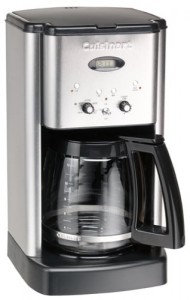For Christmas this year I got a new coffee pot. Among the wonders it offered over and above our old coffee pot (in addition to working) was a fabulous keep-warm feature that holds a pot of coffee at steaming hot perfection for four hours! Amazing, what will they think of next?
While I love the convenience of on-demand hot coffee, Erica raised an interesting question: is this the most energy efficient way to keep our coffee hot? Is it, she posited, more energy efficient to make a pot and re-heat extra cups in the microwave when we need a refill?
Battle Coffee Pot
My efforts to calculate the answer got sidetracked with estimates of how closely a half-full pot of coffee approximates a black body and if the radiation emitted follows Planck’s Law. Internet research and back-of-the-envelope math told me only one thing: the winner of Battle Coffee Pot vs. Microwave was going to be too close to call without empirical research.
To get the hard facts I needed, I walked down to the local library and checked out a Kill-A-Watt, a handy plug-in power meter that the local utility company makes available through the library system. (Read more about how we used a Kill-A-Watt to assess the energy cost of our garage freezers.)
Ready now to collect some data, I tested three scenarios:
- Using the coffee pot’s keep-warm feature
- Reheating coffee in the microwave
- Brewing two smaller batches
In all three cases I started with the same temperature water (90 degrees Fahrenheit) and kept the temperature of the kitchen the same (66 degrees Fahrenheit).
For the keep-warm and reheat approaches I made a four-serving batch and poured two servings of coffee right away, a third one after an hour, and the fourth and final one after a second hour.
When reheating the coffee in the microwave, I took the third and forth servings to 168 degrees Fahrenheit, the temperature at which a refill of the keep-warm brew ended up after being poured.
For the two-batch method I simply made a half-size two serving batch, waited two hours, and made another half-size.
I ran each method twice and averaged the results. I didn’t get into wildly different approaches (French press, espresso, Italian style moka pot, etc.).
Results
Coffee Pot Keep-Warm
- Initial brew: 150 Watt-hours
- Hold for 1 hour: 60 Watt-Hours
- Hold for 1 hour: 60 Watt-Hours
- Total: 270 Watt-hours
Microwave Re-heat
- Initial brew: 150 Watt-hours
- Reheat 1 cup: 30 Watt-hours
- Reheat 1 cup: 45 Watt-hours
- Total: 225 Watt-hours
Two Smaller Batches
- Initial Brew: 120 Watt-hours
- Second Brew: 110 Watt-hours
- Total: 230 Watt-hours
In the end, the Microwave Re-heat approach won the day, by a scarce 5 Watt-hours over the Two Smaller Batches approach and 45 Watt-hours over the Keep-Warm function.
Now I’m not saying that this is inconsequential, but in the great scheme of things, it isn’t very much. Compared to other energy uses, even the larger 45 Watt-hours energy cost equals:
- Leaving a single 60 Watt light bulb on for ¾ of an hour.
- Leaving all my kitchen lights turned on full for just under four minutes.
- Running an electric oven for thirty seconds.
- About 0.014% of the average American home’s daily energy consumption.
So am I advising those of you with coffee pot keep-warm features to shut them off and head to the microwave instead? Honestly, not necessarily.
The margin of improvement is small enough that you may want to think about where you spend your conservation attention – and if that attention might be better directed elsewhere. Spend a minute warming your coffee and leave the oven on during that time…and you’ve undone all the good that your carefully planned coffee strategy could have done you. So would forgetting a cup in the microwave and having to come back an hour later to re-re-heat it (and I’ve done that more often that I’d like to admit!).
As conveniences go, 45 Watt-hours for is pretty cheap in my book, a reasonable price to pay for the simple joy of hot coffee waiting for me when I come in from wheelbarrowing woodchips around the garden or waking up early to get on a transatlantic conference call.
But if conservation is part of your very being, a continuous effort to pick at every detail of waste and inefficiency in your world, then those 45 Watt-hours may well make the difference between satisfaction and frustration.
So the ultimate decision is one of values and tradeoffs – pick yours, and enjoy a cup of coffee however you choose to make it!
The Fine Print
As fun as kitchen geek stuff is, the results of these same experiments done in your kitchen will vary according to the appliances you are using. Here’s what I used.
Coffee Machine: 12 cup Cuisinart
Microwave: 1300 Watt Panasonic
What Seattleites consider a “cup” of coffee, and therefore the quantity of all servings used for these experiments: 16 oz.


